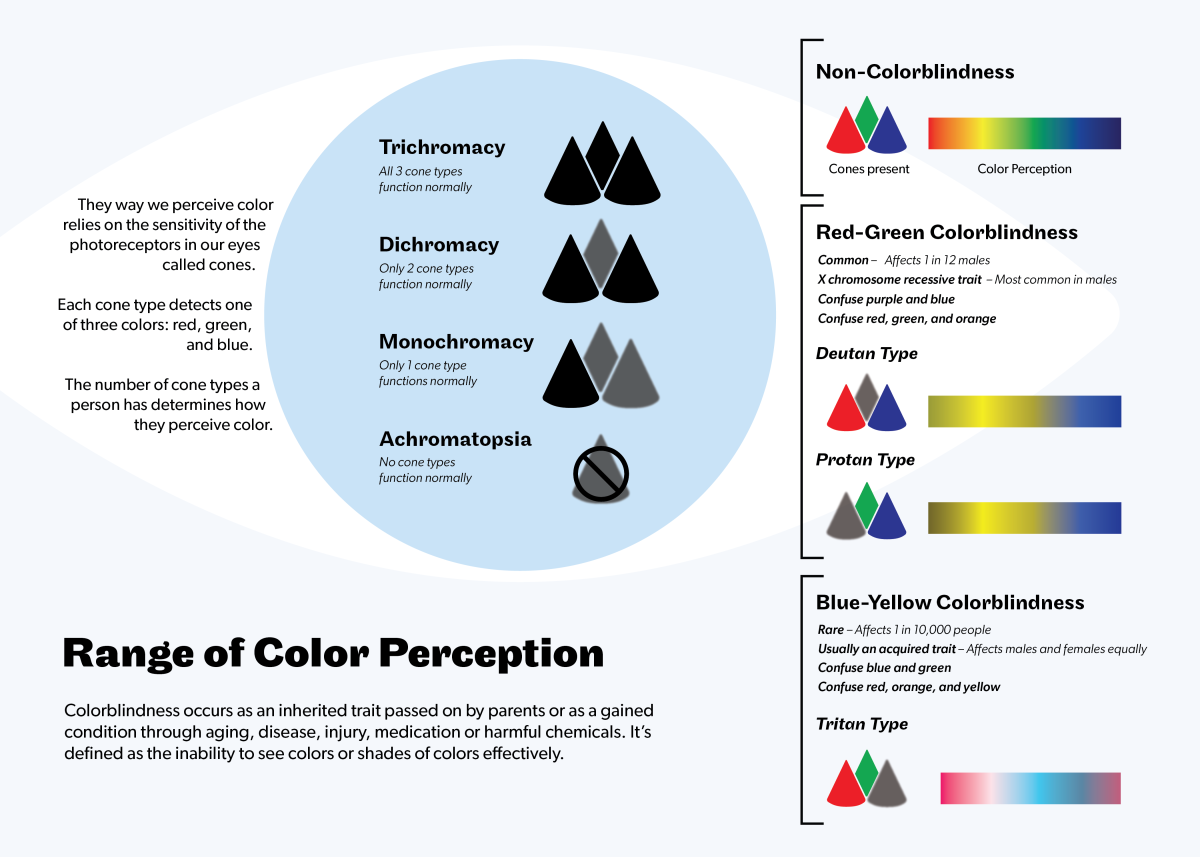
Designed by Ann Salman
colorblind infographic
On Monday, Oct. 25, the NC State Library and EnChroma offered students the opportunity to use glasses for color deficiency at no cost to them, thus allowing many students to see colors such as red and green for the first time.
Library staff, Renzo Shamey, a professor of textile chemistry, an EnChroma representative, and several NC State students working in color science operated the event. Throughout the event, Shamey explained to attendees basic information about the science of color and color deficiency.
“Most guys suffer from what we would call red-green color deficiency, and that is the most prevalent form,” Shamey said, “Then there is a milder version of that and a severe version of that and in each category: you would have individuals who are either slightly color defective or severely color defective. Then there is the yellow-blue color deficiency which is a much smaller category. Then there is the monochromatic color vision which identifies the world in shades of grey, but that is a much smaller percentage of the population, but since this is a genetic issue it varies from person to person.”
In addition to educating people about color deficiency and the types of color blindness, the event also sought to raise awareness for color blindness both inside and outside of the classroom.
When questioned about his experience at NC State, Elliott Schultz, a third-year studying computer science, said red color blindness adds extra difficulty when attending a school that has a lot of red.
“Here at State, there is a lot of red, and when you are red-green color blind a lot of things like hyperlinks and backgrounds are red and everything is red, and I just don’t know if the text is supposed to be something,” Shultz said. “It’s been difficult to figure out if it is a hyperlink or if it is just normal text.”
Furthermore, Schultz also discussed his experiences with teachers and in the classroom in regards to his color deficiency.
“It has only been once or twice where teachers sent out slides and there have been hyperlinks or data sets where they had just chose the wrong colors to use, but a lot of them have gotten better with that by using shapes or adding text,” Schultz said.
Although color deficiency is not listed as a disability at the Disabilities Resource Office at NC State, it affects 13 million Americans and 350 million people worldwide. This includes NC State alumnus, Daryn White, a graphic designer, who has been diagnosed with color blindness for over 40 years.
“First job out of college for about eight years was a graphic designer,” White said. “And I had a lot of cheats in place, like I knew how to use Photoshop and all the programs back then that everyone needed to know to be a graphic designer, but I had trouble with mostly red and green color blindness. This was back in the ‘90s; I, like most people, didn’t divulge their disability because I was afraid that I was going to get fired.”
At the event, White was one of the people who had been selected to receive a free pair of EnChroma glasses.
“It was so cool to put them on and actually see the red on campus. I have worked here for 19 years now and had never really seen the red pop until I put them on,” White said.
The University Libraries are offering a similar opportunity for students who experience color deficiency. After this event and the established partnership of EnChroma, students are now able to borrow EnChroma glasses for three days at no cost to them through Technology Lending.
For more information about the EnChroma glasses or color deficiency, you can contact the University Library.